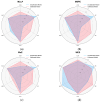A Novel Machine Learning Model and a Web Portal for Predicting the Human Skin Sensitization Effects of Chemical Agents
- PMID: 39590983
- PMCID: PMC11598222
- DOI: 10.3390/toxics12110803
A Novel Machine Learning Model and a Web Portal for Predicting the Human Skin Sensitization Effects of Chemical Agents
Abstract
Skin sensitization is a significant concern for chemical safety assessments. Traditional animal assays often fail to predict human responses accurately, and ethical constraints limit the collection of human data, necessitating a need for reliable in silico models of skin sensitization prediction. This study introduces HuSSPred, an in silico tool based on the Human Predictive Patch Test (HPPT). HuSSPred aims to enhance the reliability of predicting human skin sensitization effects for chemical agents to support their regulatory assessment. We have curated an extensive HPPT database and performed chemical space analysis and grouping. Binary and multiclass QSAR models were developed with Bayesian hyperparameter optimization. Model performance was evaluated via five-fold cross-validation. We performed model validation with reference data from the Defined Approaches for Skin Sensitization (DASS) app. HuSSPred models demonstrated strong predictive performance with CCR ranging from 55 to 88%, sensitivity between 48 and 89%, and specificity between 37 and 92%. The positive predictive value (PPV) ranged from 84 to 97%, versus negative predictive value (NPV) from 22 to 65%, and coverage was between 75 and 93%. Our models exhibited comparable or improved performance compared to existing tools, and the external validation showed the high accuracy and sensitivity of the developed models. HuSSPred provides a reliable, open-access, and ethical alternative to traditional testing for skin sensitization. Its high accuracy and reasonable coverage make it a valuable resource for regulatory assessments, aligning with the 3Rs principles. The publicly accessible HuSSPred web tool offers a user-friendly interface for predicting skin sensitization based on chemical structure.
Keywords: NAMs; QSAR; cheminformatics; computational toxicology; skin sensitization.
Conflict of interest statement
A.T. and E.N.M. are co-founders of Predictive, LLC., which develops novel alternative methodologies and software for toxicity prediction. All the other authors declare no conflicts.
Figures








Similar articles
-
Are Current Survival Prediction Tools Useful When Treating Subsequent Skeletal-related Events From Bone Metastases?Clin Orthop Relat Res. 2024 Sep 1;482(9):1710-1721. doi: 10.1097/CORR.0000000000003030. Epub 2024 Mar 22. Clin Orthop Relat Res. 2024. PMID: 38517402
-
Systemic pharmacological treatments for chronic plaque psoriasis: a network meta-analysis.Cochrane Database Syst Rev. 2021 Apr 19;4(4):CD011535. doi: 10.1002/14651858.CD011535.pub4. Cochrane Database Syst Rev. 2021. Update in: Cochrane Database Syst Rev. 2022 May 23;5:CD011535. doi: 10.1002/14651858.CD011535.pub5. PMID: 33871055 Free PMC article. Updated.
-
The comparative and added prognostic value of biomarkers to the Revised Cardiac Risk Index for preoperative prediction of major adverse cardiac events and all-cause mortality in patients who undergo noncardiac surgery.Cochrane Database Syst Rev. 2021 Dec 21;12(12):CD013139. doi: 10.1002/14651858.CD013139.pub2. Cochrane Database Syst Rev. 2021. PMID: 34931303 Free PMC article.
-
Systemic pharmacological treatments for chronic plaque psoriasis: a network meta-analysis.Cochrane Database Syst Rev. 2017 Dec 22;12(12):CD011535. doi: 10.1002/14651858.CD011535.pub2. Cochrane Database Syst Rev. 2017. Update in: Cochrane Database Syst Rev. 2020 Jan 9;1:CD011535. doi: 10.1002/14651858.CD011535.pub3. PMID: 29271481 Free PMC article. Updated.
-
Rapid, point-of-care antigen tests for diagnosis of SARS-CoV-2 infection.Cochrane Database Syst Rev. 2022 Jul 22;7(7):CD013705. doi: 10.1002/14651858.CD013705.pub3. Cochrane Database Syst Rev. 2022. PMID: 35866452 Free PMC article.
References
-
- Murphy K., Weaver C. Janeway’s Immunobiology. Garland Science; New York, NY, USA: 2017. p. 840.
-
- International Regulatory Requirements for Skin Sensitization Testing—ScienceDirect. [(accessed on 11 September 2024)]. Available online: https://www.sciencedirect.com/science/article/pii/S0273230018300667?casa....
-
- OECD . Test No. 429: Skin Sensitisation: Local Lymph Node Assay. Organisation for Economic Co-Operation and Development; Paris, France: 2010.
-
- OECD . Test No. 406: Skin Sensitisation. Organisation for Economic Co-Operation and Development; Paris, France: 2022.
-
- OECD . Guideline No. 497: Defined Approaches on Skin Sensitisation. Organisation for Economic Co-Operation and Development; Paris, France: 2023.
Grants and funding
LinkOut - more resources
Full Text Sources

